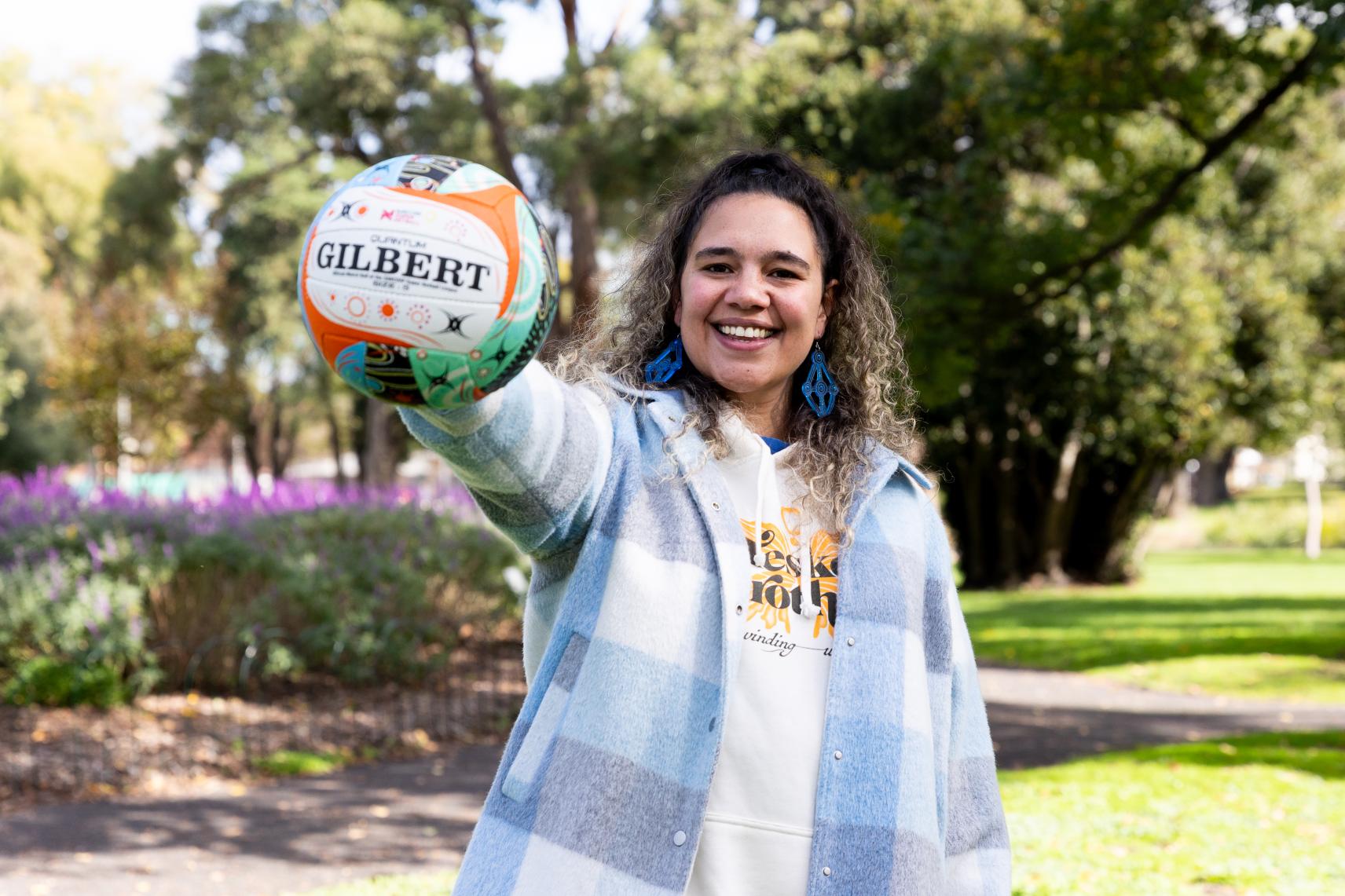By Sophie Taylor
A proud Gunai, Gunditjmara, Mutti Mutti, Yorta Yorta and Bunurong woman, Koorrin Alinta Edwards-Wanganeen’s life has been intrinsically connected with netball for as long as she can remember.
First taking to the court at just four years old, Edwards-Wanganeen’s family is heavily involved in the sport, so it was only natural that she followed her mother’s footsteps to play alongside sisters, nieces and nephews, and her husband and son.
A proud First Nations woman living in Naarm (Melbourne) and this year’s Suncorp Super Netball First Nations Round artist, Edwards-Wanganeen spoke of the deep importance of netball to her own journey and within her culture.
“Netball is extremely important to me because it comes from a matriarchal standpoint,” Edwards-Wanganeen said.
“It’s nurturing, it's caring, and it's all about the women for majority of it, which is amazing. I feel like it empowers young women to become leaders.”
Edwards-Wanganeen’s connection to netball is about far more than just the game itself. In her words, it's a way of keeping connected to "all our mob".
“Back then we did the junior Aboriginal netball football carnivals, whatever kid wanted to jump on the court pretty much got an opportunity, which then opened up the amazing world of netball for myself and it progressed from there," she said.
“It’s an opportunity to be able to all come together for something really positive.”
Edwards-Wanganeen is proud of the “amazing opportunity” to show her culture and passion for netball within this year’s artwork which she has fittingly titled "Join in the Journey".
Koorrin's entire family is involved in netball.The running theme touches on that deeper connection, but also about each person's individual journey in the sport.
“The design is about joining in the journey, and that's the title of the artwork,” Edwards-Wanganeen said.
“I wanted to create a piece of work that reflected something of my story, and also reflect on a lot of other Indigenous netballers that do play the sport.”
The artwork reflects more than just Edwards-Wanganeen’s own story within netball, amplifying Indigenous and multicultural communities and the importance of coming together to celebrate unity.
“Circles are a representation of gathering, celebration and coming together… gathering as a community, as a team,” Edwards-Wanganeen said.
“All the different types of circles and the different symbols around those circles are representations of the multiculturalism and inclusivity that we have in netball.
“The squiggly lines around the outside are a representation of each individual netball player’s journey through their netball career.
“The half circles are a representation of the people – the club, the people within the club, the strength that you have to put into a club, all the hard work that you do… to then in turn have a club that everyone can be really proud of.
“The straight lines, they're a representation of warriors. When you go out onto the netball court or you go to training, you’re super fierce… you're a warrior.
“You’ve got that fighting spirit to win, to win the game and go out and put everything on the court.”
First Nations Round will run over rounds seven and 13 this year.Edwards-Wanganeen’s artwork is deeply personal, and a physical representation of her own journey and growth as a First Nations woman.
“A lot of my inspiration for my artwork is how I get to determine how my story is told,” Edwards-Wanganeen said.
“My journey through my artwork is a space for healing, for myself, and it's also something that I can immerse myself into and completely get lost in without worrying about anything else that surrounds me.
“I really do love doing my artwork, particularly for that reason, because it's just about me, but it's also a way that I can share who I am to everybody else.”
Edwards-Wanganeen reflects more than just herself in her artwork, using circles, linework and colour to reflect today’s society.
“It's also a reflection on how I live in the two worlds between being a strong Aboriginal woman living in today's society and how different that is to how we used to live as First Nations people," she said.
“That’s really important to introduce into my artwork and represent through that platform as well.”
Art is not necessarily something Edwards-Wanganeen “got into”, but simply part of her since as long as she can remember.
“Art is probably one of our oldest living creations. That's what makes us exist for such a long time and it's how we have been able to tell our story throughout time,” Edwards-Wanganeen said.
“A lot of our art is 45,000 years old and that's insane – the longest living civilization.
“I'm really, really proud of that, and one way that I can repay my ancestors is by displaying my artwork and enjoying it.”
Edwards-Wanganeen also explained the importance of storytelling to her ancestors and how that informs the way she creates her artwork now.
“Prior to colonization, this was our way of communication and this is our way of telling our story because we did not write everything physically, we didn't have a language we could write down,” Edwards-Wanganeen said.
“A lot of that was storytelling verbally, through our artwork and other aspects.
“It's another way that I'm able to carry on our cultures and traditions in today's society, and I love to immerse that together because it's something that I am really, really proud of.
“So, in whole, it's Joining in the Journey and I really hope everyone enjoys it.”
The artwork represents coming together, celebrating and connecting with one another through netball.Artwork © Koorrin Alinta Edwards-Wanganeen
Proud Gunai, Gunditjmara, Mutti Mutti, Yorta Yorta and Bunurong woman.
‘Join in the Journey’ 2023
